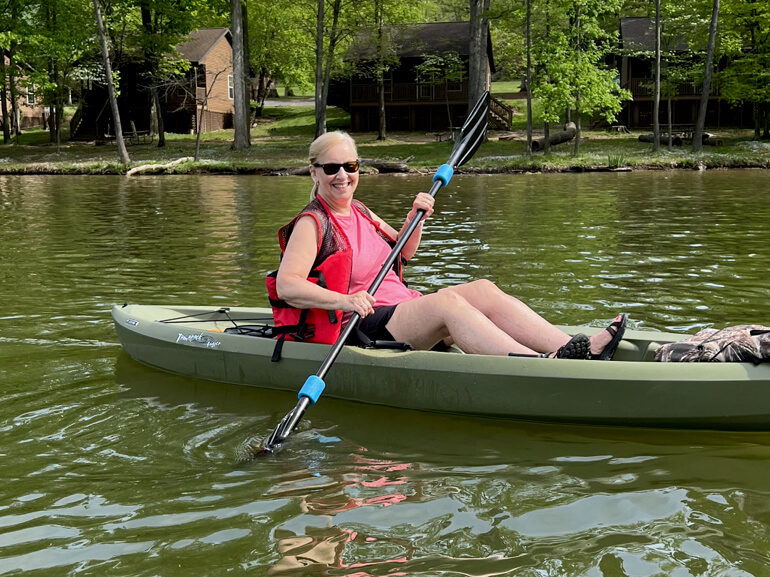Ruth's story

Ruth Kaufman’s energy is a perfect match for a life dedicated to working with children. She spent 17 years running a home daycare and worked as a pre-kindergarten instructional assistant for almost two decades. The active 63-year-old also loves the outdoors, particularly biking and kayaking. She and her husband, Wayne, have two adult daughters and several grandchildren. Although Ruth has always been a positive person, she never realized how important that attitude would be in the face of a challenging health journey.
After riding an ATV during a family visit, Ruth twisted her back getting off the vehicle. She experienced back pain and managed it with heating pads and pain medication for the next two weeks before going to the beach with Wayne. While on vacation, the pain became excruciating, and she couldn’t get out of bed without her husband’s help. They visited a pain management clinic for a steroid injection and pain medication and returned home. When Ruth started experiencing chest pain, she went to the emergency department, informing doctors there that something also felt off with her legs. When she tried to stand up but faltered, she was sent immediately for an MRI, where doctors saw a severe compression fracture of one of her vertebrae which was pressing into her spinal cord and and a mass.
Ruth underwent spinal fusion surgery and had the mass removed. Testing revealed that the mass was a tumor of plasma cells, a rare form of blood cancer. After weeks of recovery in the hospital, she admitted to Penn State Health Rehabilitation Hospital for spinal cord injury (SCI) rehabilitation. Reflecting on the chain of events, Ruth felt the injury was a blessing, as the cancer was discovered in an early stage and the hope is that it can be successfully treated. Upon arrival at the rehabilitation hospital, Ruth couldn’t raise her left leg or walk, saying her “left leg felt dead.” She needed two people to help her move around in bed or take a few steps with parallel bars, even then, she could only stand for a minute. Both legs were weak, and she couldn’t move her left ankle. Ruth was not only determined to stand and walk, even if it required a cane or walker, but to return home to her family.
The rehabilitation team was compassionate and encouraging. They included her in establishing goals and pushed her to succeed in her treatment plans. Ruth used a variety of therapy equipment including transfer boards to move from her bed to a chair, parallel bars to support her bodyweight with her arms while she worked on walking and a car stimulator to prepare for getting in and out of a car. Her therapists also applied neuromuscular stimulation during therapy, which uses low level electrical impulses to increase blood flow to the leg muscles. Ruth found electrical stimulation for her left leg very beneficial in helping to “wake that leg up.”
An a-ha moment for Ruth was being able to take several consecutive steps during therapy – she realized she might be able to leave her rehabilitation program walking instead of in a wheelchair – a goal even beyond what her therapists had expected. Ruth worked hard with her recreational therapist with the goal of getting back to the outdoor activities she enjoyed, including kayaking. Her therapists even constructed a mock kayak from wedges and gym equipment so she could work on getting on her feet from a ground level position as would be required for a successful return to kayaking. In addition to her individual therapy, Ruth attended group therapy sessions where she was a source of positivity and encouragement to the other patients.
As Ruth’s therapy progressed, she began regaining muscle function and strength and progressed from using a walker with several people assisting to a standard rolling walker with assistance from a therapist. Soon after, Ruth was fitted with an ankle brace, which enabled her to walk more than 200 feet with a rolling walker and complete transfers independently.
Despite the distance between their home and the hospital, Ruth’s family remained a strong support, visiting on weekends and encouraging her. With the direction of her care team, Wayne built various items to assist Ruth in anticipation of her return home, including a ramp, transfer benches and grab bars. “Whatever it is, I’m sure Wayne can build it,” Ruth said.
After completing the rehabilitation program in four weeks, Ruth will be meeting with the oncology department to discuss her cancer treatment. Although she hopes to return to her pre-kindergarten class, she is also open to retirement. However, nothing will stop Ruth from spending time with her grandchildren. “I will go to my grandchildren’s games in a wheelchair if I have to. I won’t let this stop me,” she said. She is also looking forward to a successful return to kayaking.